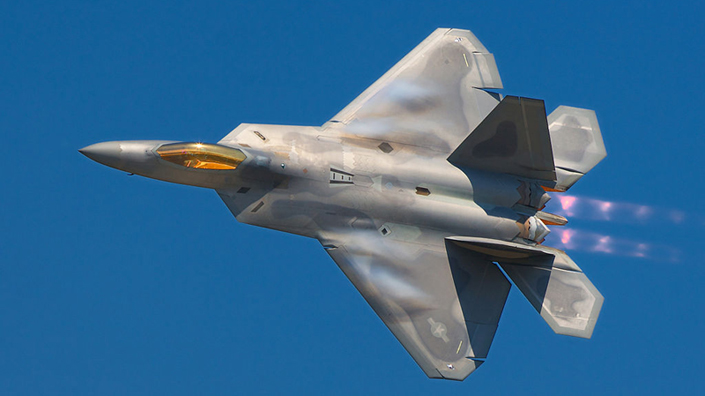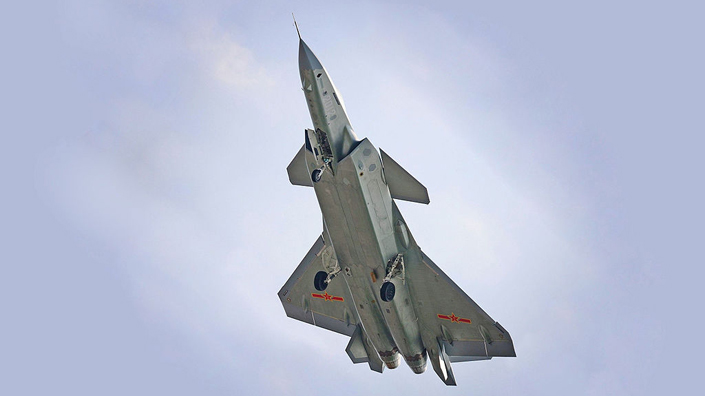The move will bring the aircraft, in development since 2010, closer to its final tests next year – and to the planned delivery to the military in 2018.
Also known internally as T-50 or by its programme name PAK-FA (Perspective Aviation Complex of Frontline Aviation), the Su-57’s top speed is 1,600 mph (2,575 km/h) – faster than the F-22, which maxes out at 1,498 mph (2,411 km/h). The new fighter jet will be equipped with K-77M missiles, expected to have a range of 125 miles – greater than the US AIM-120D that has a range of about 100 miles, based on reported specs.
“Every country probably wants planes such as this, and we have them,” aerospace force commander-in-chief colonel general Viktor Bondarev told Russian media in July. History, however, suggests a note of caution: the Soviet Union’s MiG-29 fighter jet, for example, was also rumoured to outperform their American counterparts, only to be found wanting in real life.
The pre-production batch of the Su-57 amount to 12 stealth fighters, said Yuri Slyusar, the chief executive of Russia’s United Aircraft Corporation. Russia expects to have 55 in service by 2020 and potentially a total of about 160. By contrast, there are 187 F-22s in service with the USAF, and the US aims to acquire over 2,500 F-35s for the USAF, US Marines and US Navy.
Regardless of the relatively modest final number of the jets, the combat plane is "a big step forward for Russia," Tim Robinson, editor in chief of AEROSPACE, the magazine of the Royal Aeronautical Society, told
PE. “This is the first Russian aircraft that has been designed from the ground up to be a stealth fighter.” But how good is it?
Is Su-57 better than other stealth fighters?
The Su-57 is classed as a Fifth Generation Fighter Aircraft, just like the Lockheed Martin F-22 Raptor. It has supercruise (the ability to fly beyond Mach 1 without using afterburners) and supermaneuverability (its thrust vectoring engines and flight controls permit manoveres that would see normal aircraft fall out of the sky). It also features advanced sensors, such as an AESA (active electronically scanned array) radar, which uses an electronically steered antenna – allowing for longer ranges, enhanced detection and simultaneous air/surface modes.
 Lockheed Martin F-22A Raptor (Credit: Rob Shenk, Creative Commons)
Lockheed Martin F-22A Raptor (Credit: Rob Shenk, Creative Commons)
However, Robinson noted that in the West “the consensus is that it’s not perhaps the equal of F-22. It’s more optimized for supermaneuverability and frontal stealth – whereas F-22 is more all-aspect stealth – note the attention given to the Raptors rear engine nozzles. The Russians are perhaps hedging their bets on the importance of maneuverability.”
And, he added, there are still two weak points. The first one is engines, which “always has been a weak point of Russian aircraft”. The fighter is currently flying with an interim set of 117S engines, and the plan is to mount and fly an upgraded version sometime this autumn. “Exact specifications are scarce, but the new slightly more powerful engines should deliver a welcome performance boost for the fighter," said Robinson.
The second weakness, said Robinson, is the build quality and the manufacturing tolerances. “It’s extremely important in stealth. If you look at the rear of MiG-29, and compare with (the Western) F-16, both of the previous generation, the rear of MiG-29 looks a bit tractor-like - it’s industrial. It’s important to use precision manufacturing, because if you get it wrong, you destroy the entire point of stealth.”
And mistakes do happen. One story recalls Lockheed Martin testing the F-117 stealth fighter on a remote range, when it got detected by the radar. It took the company a while to work out why – until someone realised there was a screw head protruding underneath the aircraft by a minuscule amount that had made it detectable. “These are the manufacturing tolerances you have to aim for, and if you don’t have those, you’ve got a less effective stealth fighter. Some observers think that Su-57 still has some of that ‘rough and ready-built’ quality, and therefore it's not going to be as stealthy as F-22 and F-35,” said Robinson.
Just how 'invisible' can it be?
Despite the stealth technology being portrayed as ‘invisible’, there is no such thing as a 'totally invisible' stealth fighter.
“What stealth does is – through materials and shaping – reduce the range at which a radar and other sensors can detect you,” said Robinson. "You can still be detected but by then it is too late. Or you can slip past enemy radar nets without them detecting you, to do your mission.”
 The Chengdu J-20, Chinese stealth fighter (Credit: V587wiki, Creative Commons)
The Chengdu J-20, Chinese stealth fighter (Credit: V587wiki, Creative Commons)
Will it be used by other countries?
Russia is one of only three countries in the world to have its own stealth aircraft, alongside the United States and China.
India is keen to acquire and co-develop a stealth fighter, said Robinson, and for a while was thinking about the Su-57. But it has also become "worried about reliability and build quality, which to my mind, is not a brilliant advert," he added.
Will the tech help produce the next passenger supersonic plane?
It’s unlikely that an engine powering the Su-57 would be used for a supersonic civilian aircraft. Ever since Concorde’s last flight, there have been multiple developments in passenger planes aiming to get you from London to New York in two hours or less.
US space agency NASA is working on a concept for a new supersonic plane, as are Boeing and Aerion Corporation. One of the key stumbling blocks is the engine, said Robinson. The Concorde had the Rolls Royce Olympus engines, which were also used in the Avro Vulcan bomber plane. But there was a problem – supersonic flight generated sonic booms on the ground. This meant that in the US opposition to this sonic booms saw Concorde restricted from overland supersonic flights. “With overland supersonic flight restrictions, airline interest in Concorde evaporated,” he said.
For a supersonic civilian plane to appear, aerospace engineering companies would have to modify their engines, or develop new ones. At the moment, there is a choice between high bypass type engines used on the Airbus A320 and A380, or Boeing 737, which are big, very efficient, but optimized for slower airliners.
The alternative are turbo jet engines, such as the EJ 200 powering the Eurofighter Typhoon. “Those are extremely powerful engines that will push aircraft capacity to Mach 1 and Mach 2, but they are very, very thirsty,” said Robinson.
“For any supersonic commercial aircraft, you have to see how to build an engine that doesn’t exist at the moment."